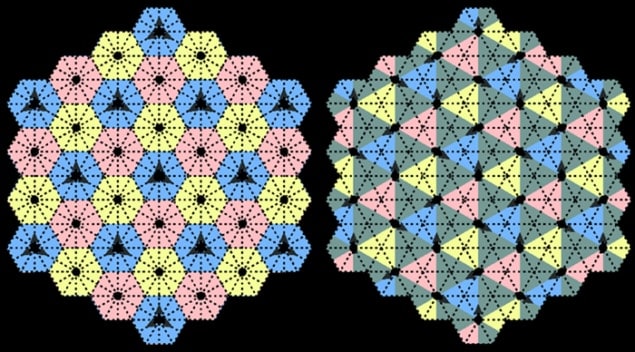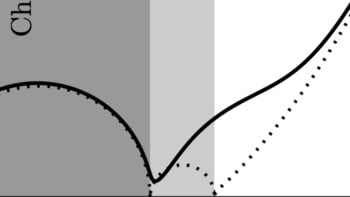
A new type of crystal defined in terms of the relative motions of its constituents has been proposed by three physicists in Canada. The researchers came up with the idea of “choreographic crystals” while thinking about how to use several satellites to detect gravitational waves. They realized that the mathematics describing the synchronized orbits of four satellites can be generalized to describe the choreographed motions of lots of objects. The trio speculates that such crystals could exist in real materials and have devised a way to identify such systems, if they exist.
The new concept of “choreographic crystals” has been developed by Latham Boyle, Jun Yong Khoo and Kendrick Smith of the Perimeter Institute for Theoretical Physics (PI) in Waterloo, Ontario. The idea took shape several years ago when Boyle was looking at how the upcoming Laser Interferometer Space Antenna (LISA) mission will use three satellites orbiting the Sun to detect gravitational waves. The satellites are set in a triangular configuration and will monitor each other’s locations using laser beams to detect tiny changes in their positions that occur when a gravitational wave passes through the solar system.
Hidden symmetry
LISA will shed light on the origin and polarization of the gravitational waves it detects, but Boyle suspected that adding a fourth satellite would give even more useful information. However, he quickly realized that a spatially symmetric orbital configuration involving four satellites did not exist. Undeterred, Boyle realized that his focus on spatial symmetry was limiting his options – and that a symmetric orbit of four satellites can occur when plotted in terms of the satellites’ velocity and position.
“It turns out there’s this really, really symmetric orbit for four satellites,” explains Boyle, who describes the configuration as a “dynamic tetrahedron”. His interest piqued, Boyle wondered if the concept could be generalized to include more satellites, and joined forces with his PI colleagues Smith and Khoo to find out.
Smith quickly developed a way of finding all possible symmetric satellite swarms with “choreographic order”. Unlike conventional crystals, which are unchanged by spatial operations such as translation, reflection or rotation, these dynamic crystals are unchanged by combinations of changes in space and time. A certain rotation of a dynamic crystal, for example, puts the system into the same state as it would be in after evolving for a certain time.
Into the blue
The trio also came up with a way of illustrating choreographic order. The above figure shows two examples of 2D choreographic crystals with high degrees of symmetry. In the crystal on the left, each element is at the centre of a blue hexagon and can follow a trajectory first through a yellow hexagon, then through a pink hexagon and then back to a blue hexagon – the movement occurring in one of three possible directions shown by the arrows. In the crystal on the right, each element can also move from blue to yellow and on to pink – but only in one direction, as shown by the arrows.
While the team does not know if such choreographic order exists on a microscopic level in materials, it says it should be possible to see evidence for the phenomenon in diffraction experiments, where the positions of the diffraction peaks would be shifted. Boyle describes such shifts as a “very clear-cut signal to look for”. However, he warns, “I don’t know if these things will be out there in nature or not, but it makes sense to look for them.”
The choreographic crystals are described in Physical Review Letters.



